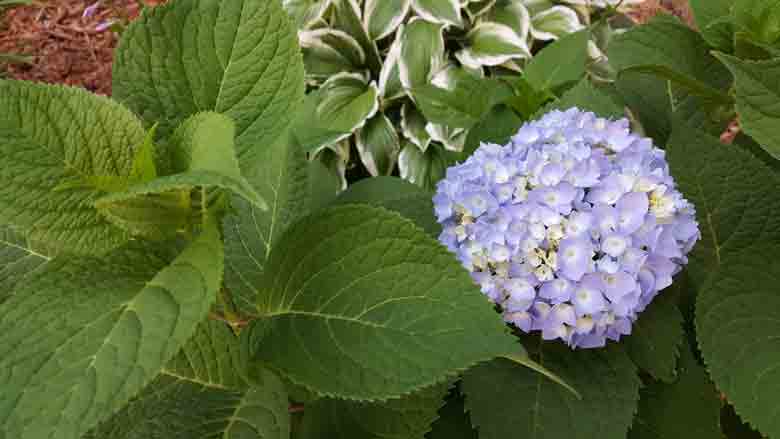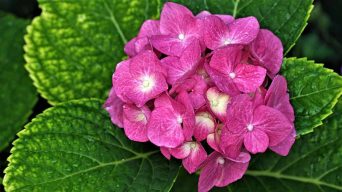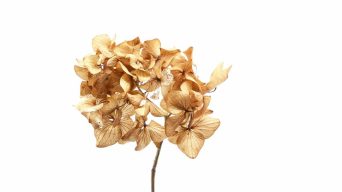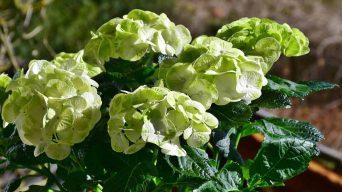Hydrangea plants are known for their beautiful blooms, but sometimes their leaves can turn yellow.
This is usually a sign that something is wrong and the plant needs your help.
There are several possible causes of yellow leaves on Hydrangeas, and luckily most of them are easy to fix.
Here we’ll cover the most common causes of Hydrangea leaves turning yellow and how to fix them.
What Causes Hydrangea Leaves to Turn Yellow?
The Hydrangea plant is a beautiful flowering shrub that can add color and interest to any garden.
However, Hydrangea leaves turning yellow can be a cause for concern.
There are several reasons why Hydrangea leaves turn yellow, and most of them are easy to fix.
Let’s look at the most common reasons why Hydrangea leaves turn yellow and how to fix them.
1. Overwatering
Hydrangea leaves typically turn yellow when the plant is overwatered.
This problem is often caused by poor drainage or excessive watering.
When the roots of a plant are submerged in water for long periods, they begin to suffocate and rot.
This process cuts off the roots’ oxygen supply, causing the leaves to turn yellow and eventually die.
Overwatering can also lead to other problems such as leaf drop, root damage, and fungal growth.
Other signs of an overwatered Hydrangea include wilting leaves, soggy soil, and root rot.
How To Fix It
If you think your Hydrangea is overwatered, the best solution is to let the soil dry out completely before watering again.
It’s also a good idea to check the drainage of your pot or garden bed and make sure that water is not pooling around the plant’s roots.
Hydrangea plants need well-drained soil to thrive.
If the drainage of your pot or garden bed is poor, you can improve it by adding sand, perlite, or vermiculite to the soil.
You should also ensure that you are not watering your Hydrangea too often.
Watering once a week should be sufficient, and more often if the weather is hot and dry.
2. Underwatering
Hydrangea leaves can also turn yellow if the plant is not getting enough water.
This occurs when the plant does not receive enough water, and the soil begins to dry out.
The leaves will turn yellow and drop off, starting at the bottom of the plant and working up.
Underwatering is a common problem, especially during hot weather when plants need more water to stay hydrated.
Other signs of an underwatered Hydrangea include curling leaves, wilting, dry soil, and leaf drop.
How To Fix It
If you think your Hydrangea is not getting enough water, the best solution is to water it more often.
Ensure that the soil around the plant is always moist but not soggy.
You may need to water your Hydrangea every day during hot weather, although once a week should be sufficient in cooler weather.
It’s also a good idea to mulch around the plant to help retain moisture in the soil.
Mulching with organic material such as bark chips or compost will also help improve the drainage and quality of the soil.
3. Fertilizer Burn
Hydrangea leaves can also turn yellow if the plant is getting too much fertilizer.
This is known as “fertilizer burn,” It occurs when the plant’s roots are exposed to too much fertilizer.
The roots can’t absorb all of the nutrients and become damaged.
This damage causes the leaves to turn yellow and eventually die.
Other signs of fertilizer burn include brown or yellow leaves, wilting, and stunted growth.
How To Fix It
If you think your Hydrangea has fertilizer burn, the best solution is to flush the soil with water.
This will help remove any excess fertilizer from the roots of the plant.
It’s also a good idea to reduce the amount of fertilizer you are using.
Fertilizing once a month during the growing season should be sufficient.
If you are using chemical fertilizer, it’s best to use one that is diluted and applied according to the manufacturer’s instructions.
Organic fertilizers such as compost or manure can also be used, but they should be applied sparingly.
4. Too Much Sunlight
Hydrangea leaves can also turn yellow if the plant is getting too much sun.
This usually happens during the summer when the weather is hot and sunny.
The leaves of the plant will turn yellow and begin to scorch.
Other signs of too much sun include brown or crispy leaves, wilting, and leaf drop.
How To Fix It
Hydrangea plants thrive in partial sun, so the best solution is to move it to a shadier location if your plant is getting too much sun.
You can also try placing a shade cloth over the plant to protect it from the sun.
Watering the plant more often during hot weather is also a good idea.
This will help keep the soil moist and cool, reducing the plant’s stress.
5. Too Little Sunlight
Hydrangea leaves can also turn yellow if the plant is not getting enough sun.
This usually happens in the winter when the days are shorter and there is less sunlight.
The leaves of the plant will turn yellow and begin to drop off.
Other signs of too little sun include stunted growth and smaller flowers than usual.
How To Fix It
If your Hydrangea is not getting enough sun, moving it to a sunnier location is best.
When growing Hydrangeas indoors, it’s essential to place them near a south-facing window where they will get plenty of sunlight.
However, you should avoid placing them in direct sunlight, as this can scorch the leaves.
It’s also a good idea to increase the amount of artificial light you are using.
You can do this by placing grow lights near the plant.
6. Pest Infestation
Hydrangea leaves can also turn yellow if the plant is infested with pests.
Aphids, scale insects, or whiteflies usually cause this.
These pests suck the sap from the plant’s leaves, causing them to turn yellow and eventually die.
Other signs of a pest infestation include stunted growth, leaves with holes in them, and sticky substances on the leaves.
How To Fix It
If your Hydrangea is infested with pests, treating the plant with neem or horticultural oil is the best solution.
It’s also good to remove any affected leaves from the plant.
You can do this by hand or with a pair of pruning shears.
It’s also a good idea to check the plant regularly for pests and remove them as soon as you see them.
7. Fungal Diseases
Hydrangea leaves can also turn yellow if the plant is infected with fungi.
The most common diseases that affect Hydrangeas are powdery mildew and leaf spot.
These diseases cause the plant’s leaves to turn yellow and eventually die.
Other signs of diseases include the plant’s leaves turning brown or black, and the plant may also produce fewer flowers.
How To Fix It
If your Hydrangea is infected with a disease, treating the plant with a fungicide is best.
You can also try to remove any infected leaves from the plant.
To avoid spreading the disease, ensure to disinfect your scissors before cutting any leaves off.
8. Temperature Stress
Hydrangea leaves can also turn yellow if the temperature stresses the plant.
This usually happens when the plant is exposed to extreme cold or heat.
The leaves of the plant will turn yellow and begin to drop off.
Other signs of temperature stress include wilting, browning, and leaf drop.
How To Fix It
If the temperature stresses your Hydrangea, you need to move the plant to a location where it will be protected from the extreme cold or heat.
You can also try to provide the plant with some partial shade if exposed to direct sunlight.
You can also try adding mulch around the plant base to help regulate the temperature.
When growing Hydrangeas indoors, make sure to place the plant in a location where it will not be exposed to drafts or direct sunlight.
Hydrangea plants need to be in an environment between 60 and 70 degrees Fahrenheit to thrive.
9. Nutrient Deficiencies
Hydrangea leaves can also turn yellow if the plant is deficient in nutrients.
The most common nutrient deficiencies that affect Hydrangeas are iron and nitrogen.
When iron levels are too low, the plant’s leaves become yellow while the veins remain green (iron chlorosis).
Nitrogen deficiency causes the lower, older leaves to become light yellow and the entire plant to grow more slowly than usual.
Other signs of nutrient deficiencies include stunted growth, flowers that are smaller than usual, and leaves that are misshapen.
How To Fix It
If your Hydrangea is deficient in nutrients, you need to fertilize the plant.
You can use a fertilizer that is high in iron and nitrogen.
Adding compost or manure to the soil around the plant is also a good idea.
This will help to increase the nutrient levels in the soil.
10. Root Rot
The leaves can also turn yellow if the Hydrangea plant has root rot.
This is usually caused by overwatering or poor drainage.
When the plant’s roots are submerged in water for too long, they begin to rot.
One of the most common root rot symptoms is yellowing leaves, as the fungus prevents the roots from absorbing nutrients from the soil.
As a result, the leaves turn yellow and eventually die.
Other signs of root rot include stunted growth, wilting, and leaf drop.
How To Fix It
Check the roots of your Hydrangea if it has root rot.
If they are black or brown, then they are probably rotten.
If some healthy roots are left, you can try to save the plant by replanting it in a new pot with fresh soil.
Trim off any rotten roots and make sure the pot has good drainage.
Water the plant carefully, making sure not to overwater it.
If your Hydrangea is heavily affected by root rot, starting with a new plant is best.
11. Natural Causes
Natural causes can also cause yellow hydrangea leaves.
The most common cause is the plant’s age.
As Hydrangeas age, their leaves will slowly turn yellow and brown before falling off the plant.
This is a normal process and is nothing to worry about.
Plants shed their leaves to conserve energy and resources.
The process is called abscission and usually happens in the fall when the days start to get shorter and the temperature begins to drop.
During this time, Hydrangeas will stop producing chlorophyll, which causes their leaves to turn yellow.
How To Fix It
There is no need to worry if your Hydrangea leaves turn yellow due to age or abscission.
This is a natural process; the plant will eventually shed its leaves.
You can help the plant by ensuring it is getting enough water and nutrients.
You can also mulch around the plant base to help it retain moisture.
Why Are Hydrangea Leaves Turning Yellow and Falling Off?
There are several reasons why hydrangea leaves might turn yellow and fall off.
One possibility is that the plant is not getting enough water.
Hydrangeas are known to be thirsty plants, so make sure to water them regularly, especially during hot summer months.
Another possibility is that the plant is getting too much sun.
If the leaves are exposed to direct sunlight for hours, they may turn yellow and eventually fall off.
Finally, it could be that the soil around the plant is too alkaline or too acidic.
To solve this problem, you can add a layer of mulch around the base of the plant to help regulate the soil’s pH level.
If you follow these tips, you should be able to keep your Hydrangea plants healthy and prevent them from turning yellow.
Hydrangea Leaves Turning Yellow After Planting?
If your Hydrangea’s leaves turn yellow immediately after planting, it is likely due to transplant shock.
This is perfectly normal, and nothing to worry about – the plant will eventually recover as it acclimates to its new environment.
To help speed up the process, ensure the plant is getting enough water (but not too much!) and avoid fertilizing it until it has established itself.
Hydrangea Leaves Turning Yellow in Winter?
There are a few reasons why Hydrangea leaves might turn yellow in winter.
One possibility is that the plant is not getting enough sunlight.
During the winter months, the days are shorter, and the sun is not as intense, so make sure to place your Hydrangea in a spot where it will get at least six hours of sunlight each day.
Another reason for Hydrangea yellow leaves in winter could be too much water.
Hydrangeas don’t need to be watered as often in winter because they are dormant, so make sure you’re not overwatering your plant.
Finally, the leaves might be turning yellow due to temperature stress.
Hydrangeas like cooler temperatures, so if the plant is in a spot that gets too hot or too cold, the leaves will turn yellow.
If you think temperature stress might be the issue, try moving your Hydrangea to a different location or protecting it from the elements with a burlap wrap.
Final Thoughts
Hydrangea plants are generally trouble-free.
If your hydrangea leaves turn yellow, it is most likely due to one of the above reasons.
By taking a closer look at your plant and following our outlined solutions, you should be able to get your Hydrangea back to its former glory in no time!
Thanks for reading, and good luck!







